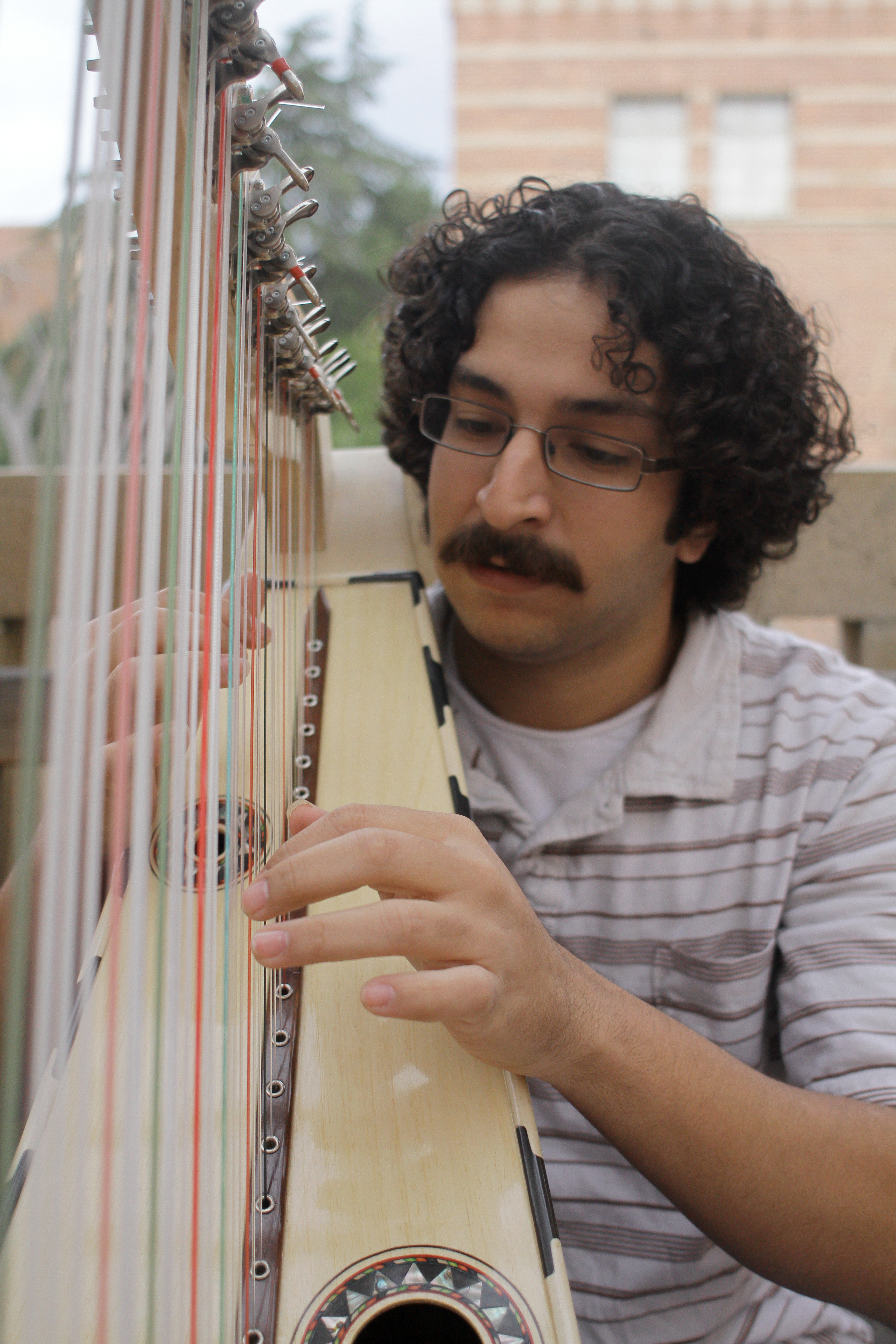Teaching assistant blends music with science

Julio Rodriquez likes to teach students by playing a variety of different instruments for them.
By Nikki Somani
Feb. 25, 2013 1:28 a.m.
Mathematical equations and diagrams scribbled on the board behind him, a physics teaching assistant pulled out his harp, affectionately named Drusilla, during class. He plucked a thin string on the instrument.
Showing his students how the string waved back and forth, he then placed his finger on the middle of the string and plucked the same note, visually explaining the concepts he had written down minutes before.
Julio Rodriguez, a graduate student in the department of physics at UCLA and teaching assistant for Physics 6B, uses instruments to demonstrate concepts for his astronomy, engineering and physics classes.
“A lot of people take physics and think it’s all math,” Rodriguez said. “But it’s not math. Math is the language that we discuss physics in.”
Rodriguez transferred as an undergraduate from El Camino College to UCLA in the fall of 2009, he said. He graduated with a degree in physics in 2011 and is now a graduate student in the physics department.
He came up with the idea of using instruments in the classroom while he was teaching astronomy and a class on electricity and magnetism during his first year as a graduate student. As he was tuning his violin one evening, he realized he could use the instrument to do a demonstration on sound interference by plucking different strings, he said.
“I wanted to give (students) something to listen to, and I was trying to think of what it could be,” Rodriguez said. “Whenever I’m trying to think of something or I just need a break, I go to my instruments.”
Rodriguez said he first started playing musical instruments in high school, when he found an old keyboard in his garage and tried teaching himself to play through the Internet. After realizing that learning piano without an instructor was too difficult, he decided to buy a guitar and teach himself basic strum patterns, like the waltz and the polka.
Since then, Rodriguez said he has learned to play the violin, harp, viola, piano, harmonica and two different types of rhythm guitars.
“It’s a source of happiness,” Rodriguez said. “Once you get an instrument to sound just the way you want it, there’s no better feeling on the planet. It’s creating something from nothing.”
Virginia Frazier, a violin professor at El Camino College, taught Rodriguez how to play the instrument in the spring of 2009. She said she is not surprised Rodriguez thought to incorporate instruments into his teaching because music and physics can be closely interrelated.
“You could almost approach the violin from a purely physics standpoint because it’s the vibration of a string,” Frazier said. “It’s physics come alive.”
Rodriguez said he has found that his musical demonstrations keep the students engaged and help to explain concepts that may have previously been unclear.
Albert Ngo, a student in Rodriguez’s Physics 6B section, said his favorite demonstration was one with a glass Coke bottle. Rodriguez first blew across the top of the bottle, which created a high-pitched noise. He then drank half of the bottle, blew across the top again and explained that the pitch was lower because more air was vibrating in the bottle – the concept of open-tube resonance.
“It’s different from a normal, boring discussion,” Ngo said.
Using instruments in the demonstrations has allowed Ngo to physically see the concepts, he said.
Rodriguez has spent more than $6,000 on his instruments, he said. He said he views his instruments as his children, and names them all. His violin is named Finius, his harp is named Drusilla and one of his rhythm guitars is named Walmart.
Outside of class, Rodriguez plays music in his church with a group of musicians and vocalists. The group started as a children’s choir at the church, which Rodriguez joined when he was in fifth grade. Now, almost 14 years later, he is still a part of the choir.
He said he plans to continue with his demonstrations as a teaching assistant. He will continue to perfect the sounds on his instruments such as the violin, which has taken him more than four years to learn to play comfortably.
Through his demonstrations, Rodriguez said he is able to use his passion for music to explain what he considers a permanent and steady world of physics.
“With physics and all sciences, we’re basically trying to discover the language of the universe. It’s already written. It’s already there,” Rodriguez said. “But with music, that’s something that comes from the creativity of the human mind.”


